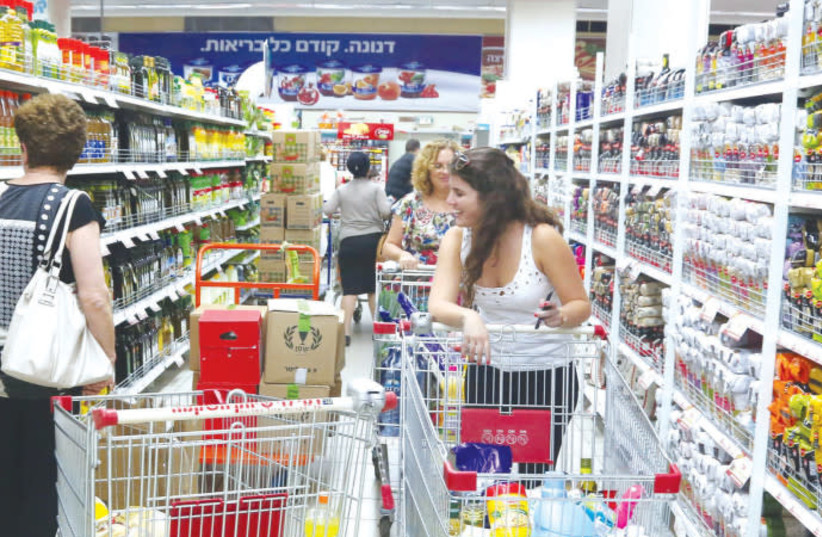Does the Consumer Price Index (CPI) published by the Central Bureau of Statistics reflect the current reality in the Israeli economy, as Covid-19 rages? The question is a pressing one, as we await the Bank of Israel's next interest rate decision and its accompanying inflation forecast.
As derived from the capital market, the rate of inflation expected in Israel over the coming year is 2.8%, close to the upper limit of the government's target range of 1-3%. This is the highest expected rate for a decade. Market analysts, on the other hand, see inflation this year running at between 1.7% and 2%. The gap between the two projections mainly arises from the difficulty in forecasting inflation because of distortions caused by the coronavirus pandemic, and also reflects problems in measuring the basket of consumer products on which the CPI is based.
While central banks around the world are already raising interest rates, inflation in Israel has remained low, among other things because of the strength of the shekel, which moderates the rise in prices of imported goods, and because Israel Electric Corporation's gas supply contracts are at fixed prices, while energy prices elsewhere are going wild. So unlike countries in which inflation has become excessively high, compelling monetary policymakers to raise interest rates, in Israel inflation is still within the target range.
It could be, however, that changes in the economy caused by the lockdowns and restrictions imposed because of the pandemic necessitate a change in the way the inflation rate is calculated. The restrictions re-imposed because of the Omicron variant, and changes in consumption habits because of the inability to fly abroad, and restrictions on cultural events, raise the question of whether the weighting of these items in the CPI ought not to be changed accordingly.
Timing problems
The CPI is determined in accordance with the Central Bureau of Statistics survey of household spending, which investigates which items an average family in Israel consumes each month. Each month, the changes in the prices of these items are measured, and the rate of change is the rate of inflation in the economy.
The main problem is in the timing, which does not keep up with actual events, something that has been particularly apparent during the pandemic. The weighting of each item in the basket is revised once every two years, on the basis of the most recent household spending survey.
The last revision was carried out in 2021 in accordance with the spending survey of 2019. Is that relevant to the period of the coronavirus pandemic, in which substantial changes took place in consumption habits as soon as the first lockdown was imposed, in March 2020?
Outdated methodology
The Central Bureau of Statistics faced a considerable challenge and tried to adapt. It also contends that even if the amendment is not precise, it should be recalled that in some cases the distortion is downwards, and in others, it is upwards.
All the same, the Central Bureau of Statistics' basket of products and services is meant to be representative, and the disruptions in demand and supply caused by the pandemic have raised questions not just about measurement and timing, but whether the CPI will reflect the future basket in the post-pandemic world.
"It is already clear that household spending does not accord with the existing weightings in the CPI, particularly in relation to overseas vacations, entertainment, and so on," says Psagot chief economist Ori Greenfeld. "What's more, when they update the CPI the next time, in January 2023, and perhaps by then we will not be under restrictions, it will be on the basis of the survey carried out in January 2021, when restrictions applied. But that's the Central Bureau of Statistics' methodology, and it's fairly similar to that of other countries."
How has the Central Bureau of Statistics nevertheless coped with the hiatus in cultural events and overseas flights because of the coronavirus pandemic? In each period in which the Central Bureau of Statistics has not measured a certain service, such as parties and celebrations, which were not measured until the economy was reopened in February last year, that item in the CPI was assigned the change in the other items. That is to say, if inflation was 1.5% last year, the Central Bureau of Statistics applied that to the suspended item in order to neutralize its effect on the CPI.
"In times like these when there are no flights, it can be assumed that certain distortions have been created that do not reflect reality, but that's true of the whole world," Greenfeld says. "By definition, price indices will always represent inflation as higher than it really is. In Israel, we think that inflation is underestimated because of home prices, which are not included in the CPI. Housing is not in the CPI in the US either, but there, the link between the rental market and the home purchase market is stronger and more rapid, so that we have seen rises in home prices quickly being translated into rises in rents. In Israel, that takes longer, but in the end, it happens."
Is there a case for making changes in the Central Bureau of Statistics' weightings?
"If it were possible to make faster updates to the weightings, it would be right to do so. But it would appear that that is not so simple, as there are thousands of products in the CPI, and the fact is that we haven't seen this happening elsewhere in the world. But the bottom line is that it would be worth considering it so that in the future the distortion will not drag on."
While the basket of products and services has been "hit" by the lack of consumption of some items such as flights and events, which have been restricted during the pandemic, products that we never thought would be a routine part of our lives, such as masks and home coronavirus test kits, have been added to it.
Along with that, changes in consumption habits as a result of technological changes, including the development of working from home, which entail changes in spending by salaried workers on goods and services, could justify at least a change in the weightings, as has partially been done in practice.
Food, electricity, dairy products — the items that will have an impact
For all that, what is the inflation outlook as we await the Bank of Israel's announcement? Osem was the first major food company to raise prices, and since imported agricultural raw materials and raw food prices have risen, Osem will probably not be the last.
At the same time, tax hikes and several regulatory changes will raise the CPI in the coming months. Mizrahi Tefahot Bank chief strategist Modi Shafrir says, "Prices of disposable utensils rose sharply in November 2021, and lifted the November CPI reading by 0.11%. Because of the global rise in raw materials prices, the Prices Committee recommended raising the controlled price of milk by 3.4%, a move that will directly lift the CPI reading by 0.03%. To these developments should be added the rise in tax on sweetened beverages, which will raise prices of soft drinks by 20%, and the CPI by 0.07%."
Shafrir provides further examples of developments that will affect the CPI. "For example, the rise in purchase tax on investment homes lifted the November CPI reading by 0.01%, In addition, because of regulatory changes by the Capital Markets, Insurance, and Savings Authority, prices of compulsory car insurance will rise by about 3% in January, and because of the jump in the price of coal, electricity prices will rise by 4.9% in February. On the other hand, water prices are due to fall by 1.8% in January."
Minister of Finance Avigdor Liberman said at the "Globes" Israel Business Conference last month that "cutting the cost of living is one of the government's greatest challenges." Liberman mentioned prices of dairy goods and fresh produce, which the Ministry of Finance wants to bring down through cutting duties and expanding imports. This, together with regulatory reform, will mainly affect the cost of living from 2023 onwards.
When we come to examine the CPI in 2023, however, we shall have to remember that, under the Central Bureau of Statistics' methodology, it will be based on data from 2021. Has the time not come for an updated version?


